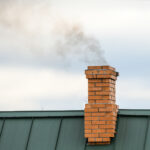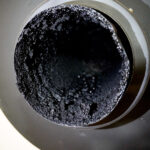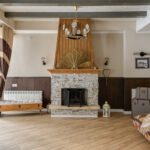What's safe to burn in my fireplace?
Stick with well-seasoned hardwood, that’s it. Burning anything else, like treated wood, trash, or even wet or green wood, can create excessive smoke, creosote buildup, and potential safety hazards. Seasoned firewood burns hotter, cleaner, and more efficiently, keeping your fireplace in better shape and your home safer.
Why does my house smell smokey?
There are many reasons why your house may smell smokey: One of the main reasons is the location of your chimney. If your chimney is located outside of the building (i.e. on an outside wall of the house), this may be the reason. Let me explain. A house typically has all windows and doors closed. This leads to two different pressure zones. The upper part of the house will be filled with warm air (+ air) which will be pulling upward, and the lower part of the house will be filled with cold air (- air) which will be pulling downward.
See Figure 1
If you have a fireplace located on the second floor, chances are it will draw efficiently. That part of the house is filled with warm, upward-pulling air. If you have a fireplace located in the basement, chances are it will not work because you are dealing with cold, downward pulling air (first-floor fireplaces can go either way). If you smell smoke during the fire, after the fire, or when the air conditioner is on, there is a good chance your house is losing positive air (like letting air out of a balloon). The house has to make up for this loss of air through whatever opening it can find. In this case, the opening is your fireplace. Example: If you leave a second-floor window open, the house will act better as a chimney than the chimney will (See Figure 2).
The exact opposite is true also. If you leave only a basement window open, the house will have more positive pressure in it (See Figure 3).
Many things in your house can affect this pressure. Any breach in the ceiling level can be a problem. An attic hatch, recessed can lights, bathroom exhaust fans without baffle, unsealed windows, and air conditioning ducts coming out of the ceiling are typical causes of the smelly problem. In the basement, the same problem can occur. Look around the 4” sewer stack as it is going through the first floor and make sure it is sealed properly. Look around the masonry chimney and any other thing that may be penetrating the first floor that goes up to the attic. If any of these items has a clear shot to the attic, the basement will be continuously losing air and can give you this smelly problem.
“How can I tell if any of these things are happening in my house?”
Generally, there is one main thing to look for: cobwebs. Cobwebs are not caused by spiders. They are caused by the continual flow of warm-to-cold air or cold-to-warm air. So, if you see cobwebs around your attic hatch, there is a strong possibility that you are losing heat out of your house continually and your house is acting as a chimney. The smell of smoke coming down the chimney is a result of your house losing too much air from the unsealed attic hatch. That air has to be replenished because your house is not going to implode, and so it is going to reenter the house in whichever way it can. Since there are no windows open, it is going to come right down the chimney and give you the smell. No one knows your house better than you. Look to find what ways air can be leaving your house. It is generally a simple and inexpensive problem to fix. Test: A good test you can perform yourself involves a cigarette and a strong flashlight. Make sure your house is closed tight for at least a few hours before you do this test. Light the cigarette and go around the house testing those areas I described above and any others you can think of that apply to your home. Let the smoke linger around those areas and hold the flashlight in a manner in which you can easily determine if smoke is leaving your building. If you do not want to perform this test on your own, we would be happy to come out and give you a consultation.
Chimney Drafting Problems Solved
Smoke Stacks, Inc. can solve your chimney drafting problems, whether it be from pressure issues to bad chimney liners (Flue Tiles) or chimney sizing issues.
Do gas fireplaces or furnaces need chimney inspections, too?
Absolutely. While has is a cleaner-burning fuel compared to wood, it doesn’t mean your chimney is maintenance-free. Bird nests, debris, or deterioration can still block the flue and affect proper venting. Plus, modern gas appliances often vent differently than older systems, and using the wrong type of flue can lead to serious performance or safety issues.
That’s why we recommend annual inspections for all chimneys, including those used with gas fireplaces or furnaces, to ensure everything is venting safely and efficiently.
What is ruining my masonry chimney?
The most important thing you should know: Water ruins masonry. Therefore, it is to your chimney’s advantage to avoid as much moisture as possible. Exterior moisture such as rain and snow can be limited with proper construction. Interior moisture in the chimney cannot be limited. Furnaces generally produce one gallon’s worth of water every hour they run. Additionally, hot water heaters generally produce a half gallon’s worth of water every hour they run. The interior lining of your chimney is being ruined by this constant flow of moisture. As time passes, the interior liner of your chimney is becoming less able to confine the products of combustion. Failure is often the end result.
Why can't I see up my chimney liner with just a flashlight?
That’s actually pretty common, and totally normal. Chimney flues are allowed to have offsets of up to 30 degrees, which means the liner may bend slightly on its way up. Because of these angles, it’s often impossible to get a clear line of sight all the way to the top just by looking up from the fireplace.
Even with a short chimney, there’s a big difference between what you can see during a basic visual inspection and what shows up during a professional video scan. That’s why we recommend video inspections when checking the condition of the flue, especially if you’re experiencing issues or haven’t had it inspected in a while.
Do I still need a liner if the water heater is the only thing venting up the chimney?
Absolutely. Your older-style masonry chimney was meant to vent a lot of heat. With the advent of newer, more efficient appliances, the small amount of heat being put up the chimney will almost all condense. If you don’t believe that, try this when the temperature is cold outside: Let everyone in your house take hot showers, wash the dogs, and do your laundry. Go outside and see if any ‘smoke’ is coming out of your chimney. There is a good chance there won’t be any. Do this same thing once you have installed the appropriate size liner. It will smoke shortly after you are on your first shower.
How can you tell what is causing my chimney to leak?
95% of water leaks are attributed to the flashing. If water passes through the flashing, it can run right down the chimney and onto your ceiling or fireplace facade. Furthermore, most of the flashing we find in the field is not done correctly. Let me explain. The flashing on your chimney needs to be able to move. The roof on your house is going to expand and contract as it heats up and cools down. The masonry chimney is not going to move. Therefore, you need to have a flashing that is going to be step flashed and then counter flashed.
Why does my fireplace smell bad, especially during the summer?
That musty, smoky odor coming from your fireplace is usually caused by creosote buildup, a natural residue left behind from burning wood. The smell often gets worse in the summer when heat, humidity, and your home’s air conditioning all work together to pull that scent down into your living space.
A thorough chimney cleaning can definitely help reduce the odor, but it may not eliminate it entirely. Some homeowners find success using chimney deodorants, baking soda, or even kitty litter inside the fireplace to absorb lingering smells.
However, the root issue is typically air being drawn down the chimney, which points to an overall pressure imbalance in your home. Installing a tight-sealing, top-mounted damper can help block unwanted airflow from coming in, and adding make-up air to your home through ventilation may also help keep the odor at bay.
Do stainless steel chimney liners need to be insulated?
It depends on what the liner is venting. Gas and oil appliances typically don’t require insulation around the liner to meet manufacturer or warranty standards, since they burn at lower temperatures and carry less risk of heat transfer to nearby materials.
However, if you’re venting a wood-burning appliance, insulation is usually a must, especially if the chimney is touching any combustible materials. In some setups, insulation is required even when there’s zero clearance to the chimney’s interior or exterior. This insulation can be a blanket wrap, masonry fill, or other approved material designed to protect your home and improve system performance.
Even in cases where insulation isn’t strictly required, like with gas or oil systems in exterior chimneys, it can still help improve draft, efficiency, and safety. So, we often recommend insulating liners whenever possible.







